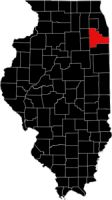Will County

Location of Will County in Illinois.

Location of Will County in Illinois.
In the winter of 1910-1911, a drifter named Charles Bosquet stopped at Julian Sprimont’s farmhouse in Will County and requested room and board for the winter. A deal was struck whereby Bosquet promised to create this large cabinet for Sprimont’s battery-operated radio in exchange for his stay. The two men went from tavern to tavern that winter collecting the wooden cigar boxes that Bosquet needed for his work.
This cabinet is part of a folk art tradition known as “tramp art,” which flourished between 1870 and 1930. Tramp art objects are typically made from wooden cigar boxes, which were carved with a penknife and then stacked and fastened with small nails or glue to create detailed, three-dimensional designs. This art form required few tools and little training to complete and was typically practiced by working class and itinerant men.
Charles Bosquet was part of a subculture of migratory laborers dubbed “hobos.” This subculture developed in America during the Second Industrial Revolution after the Civil War. As growing mechanization left unskilled laborers without jobs, unemployed men took to “riding the rails” in search of work. Although often vilified as vagrants and bums, hobos actually played a vital role in the rapid growth of the American economy, building railroads, bridges, roads, sewer systems, and taking on jobs no one else wanted to do.